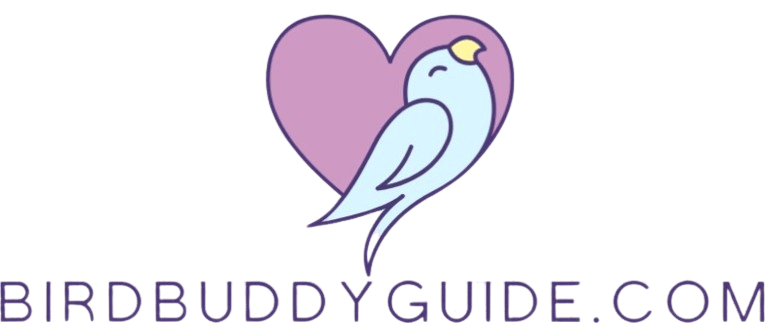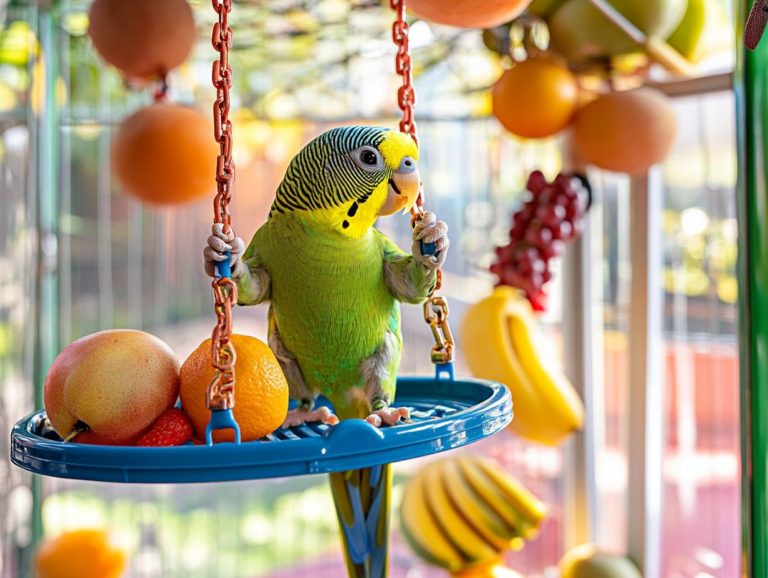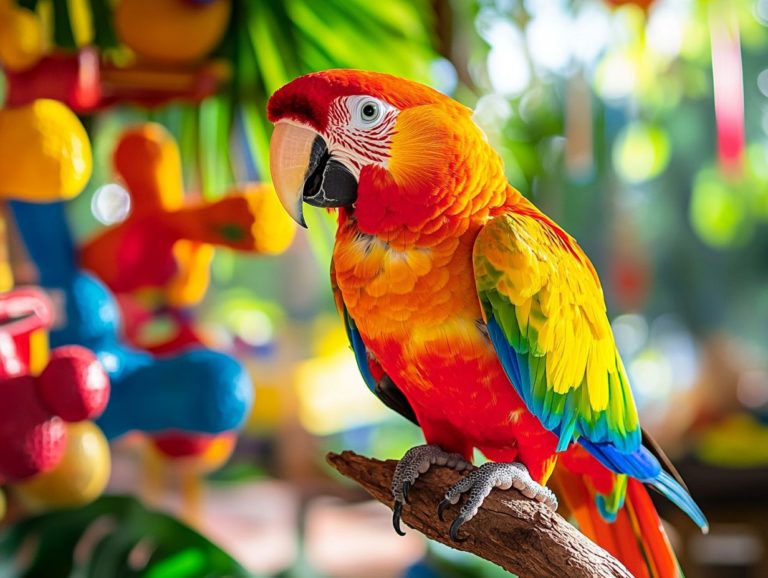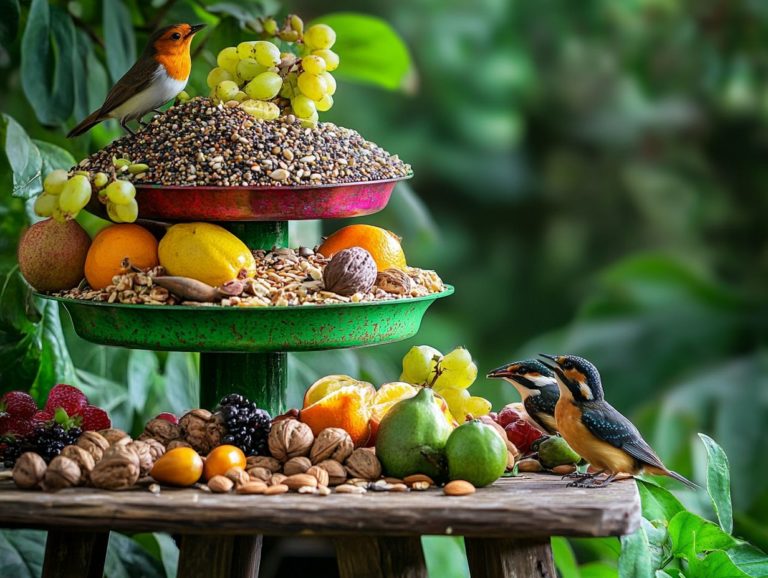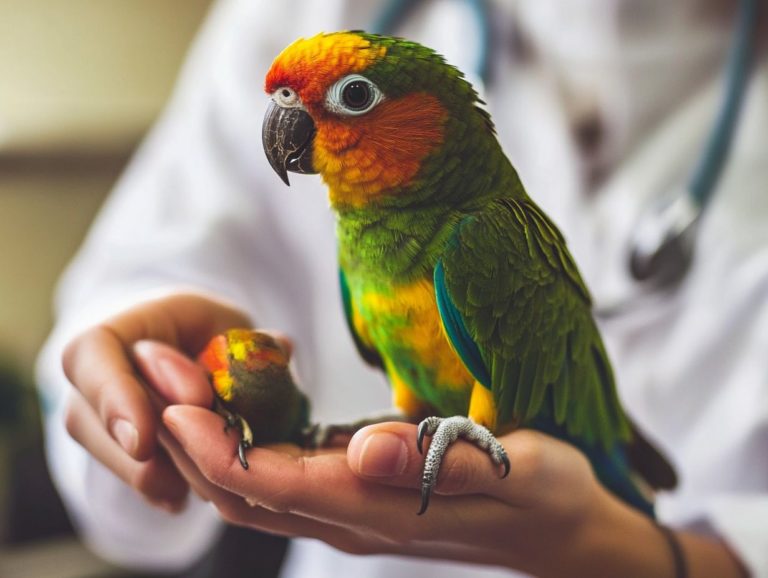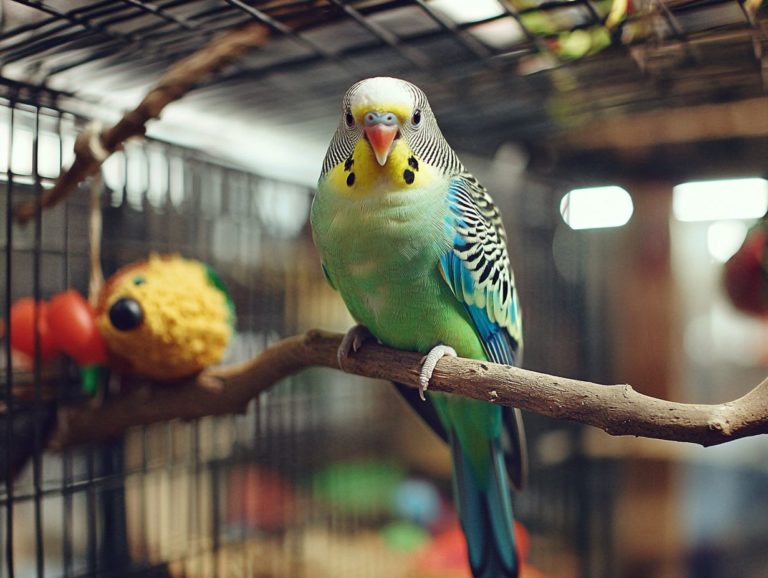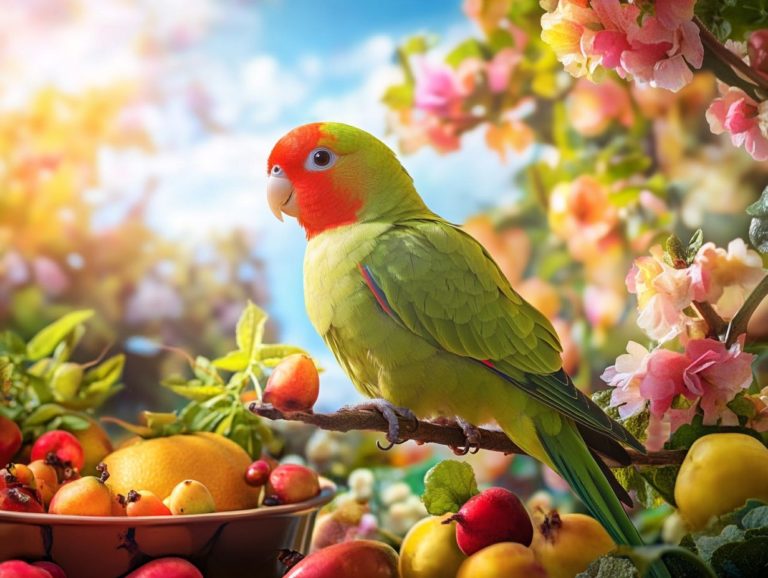Creating a Safe Habitat for Bird Health
Birds play a vital role in our ecosystems, and their survival hinges on the health of their habitats. A safe habitat is crucial for them because the quality of their surroundings directly impacts their well-being. Climate change and habitat loss pose significant threats to these habitats, making their conservation even more critical.
Key elements such as food, water, and shelter are essential. It s also important to recognize the common threats they face, including habitat loss and the impacts of climate change on their environments.
You ll find practical tips for creating and maintaining safe environments for various bird species that will ultimately benefit both avian life and humans alike. This includes planting native plants and trees in your garden to support their needs. Explore with us to uncover the intricate connections between bird habitats and human well-being.
Contents
- Key Takeaways:
- Why a Safe Habitat is Important for Birds
- Essential Elements of a Safe Habitat
- Common Threats to Bird Habitats
- Creating a Safe Habitat for Different Bird Species
- How to Maintain a Safe Habitat
- Benefits of a Safe Habitat for Birds and Humans
- Frequently Asked Questions
- What is a safe habitat for bird health?
- Why is it important to create a safe habitat for bird health?
- How can I attract birds to my yard and create a safe habitat for them?
- What are some common threats to bird health in a habitat?
- How can I prevent predators from harming birds in a safe habitat?
- What should I do if I find an injured or sick bird in my safe habitat?
Key Takeaways:
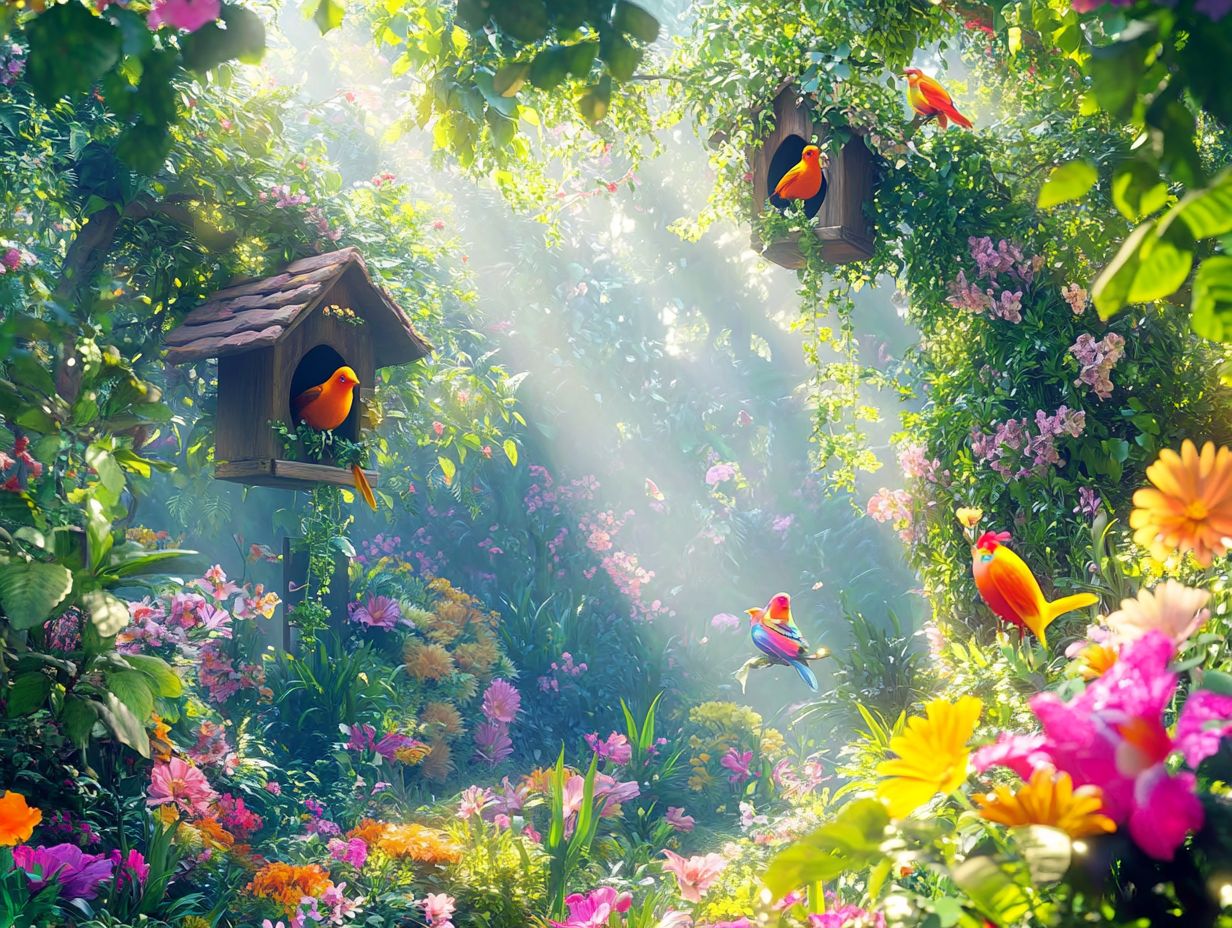
- A safe habitat is crucial for maintaining the overall health of birds and the ecosystem, especially during summer and winter when resources can be scarce.
- Key elements of a safe habitat include access to food and water. Suitable shelter and nesting areas are also crucial.
- Regular maintenance and monitoring are essential for creating and maintaining a safe habitat for birds.
Why a Safe Habitat is Important for Birds
A safe habitat is essential for birds, as it significantly impacts their survival, health, and overall well-being in an ever-changing environment. To ensure their comfort, learn how to create a safe space for your adopted bird. With the pressing challenges of climate change and habitat loss, it’s crucial to recognize how these safe spaces support vital behaviors like nesting, migration, and feeding.
Organizations like Audubon highlight the importance of safeguarding these habitats, enabling birds to thrive and play their role in maintaining biodiversity (the variety of life in the world), which is essential for a healthy ecosystem. By ensuring that birds have access to clean water, native plants, and adequate shelter, you can cultivate a healthy garden that nurtures avian life while enriching your ecosystem, especially as they prepare for migration.
The Impact of Habitat on Bird Health
The health of bird populations hinges on the quality of their habitat, which includes essential access to food, water, and shelter vital for their survival and breeding. Additionally, establishing a bird wellness routine can further enhance their well-being.
A well-rounded environment, rich in a variety of plant species, directly impacts the resources available to these birds. Diverse food sources are crucial, as different bird species have unique dietary preferences some thrive on seeds and fruits, while others rely on insects. For example, the Blackhaw Viburnum produces berries that attract numerous bird species, while the Wax Myrtle offers a bounty of insects and berries, ensuring a well-balanced diet for summer and autumn feeding.
Clean water is equally important, serving as a lifeline for drinking and bathing, which supports their vital physiological functions.
Varied shelter options, such as dense shrubs and trees like oak and beech, provide safe nesting sites and protection from predators, thereby enhancing overall bird health and fostering vibrant ecosystems.
Essential Elements of a Safe Habitat
Creating a safe habitat for birds demands a clear understanding of the essential elements vital to their survival. You’ll need to ensure there are ample food and water sources while providing proper shelter through the inclusion of native plants, trees, and shrubs that can thrive throughout the seasons. Additionally, creating a safe play area for your bird is crucial for their overall well-being.
Each component plays a crucial role in fostering a thriving environment for our avian friends.
Join us in making a difference for our feathered friends! Start planting native species today to support their health and well-being.
Food and Water Sources
Food and water sources are essential for the survival of birds. Native plants offer vital nutrition, and insects serve as a primary food source.
These crucial resources sustain various bird species and play an important role in maintaining how living things interact in nature within their habitats, especially during spring and autumn migrations.
Among the diverse offerings, seeds from sunflowers, asters, and coneflowers are particularly enticing to many birds. Meanwhile, fruits from berry-producing plants like elderberries and serviceberries provide a delightful snack.
Insects such as caterpillars and beetles are essential for nurturing young chicks and are often abundant in gardens rich with native plants.
Clean water sources whether from natural streams, ponds, or simple birdbaths are vital for hydration and bathing.
You can create inviting spaces that cater to your feathered friends’ dietary needs by learning how to create a calming environment for birds, ensuring a thriving avian community.
Shelter and Nesting Areas
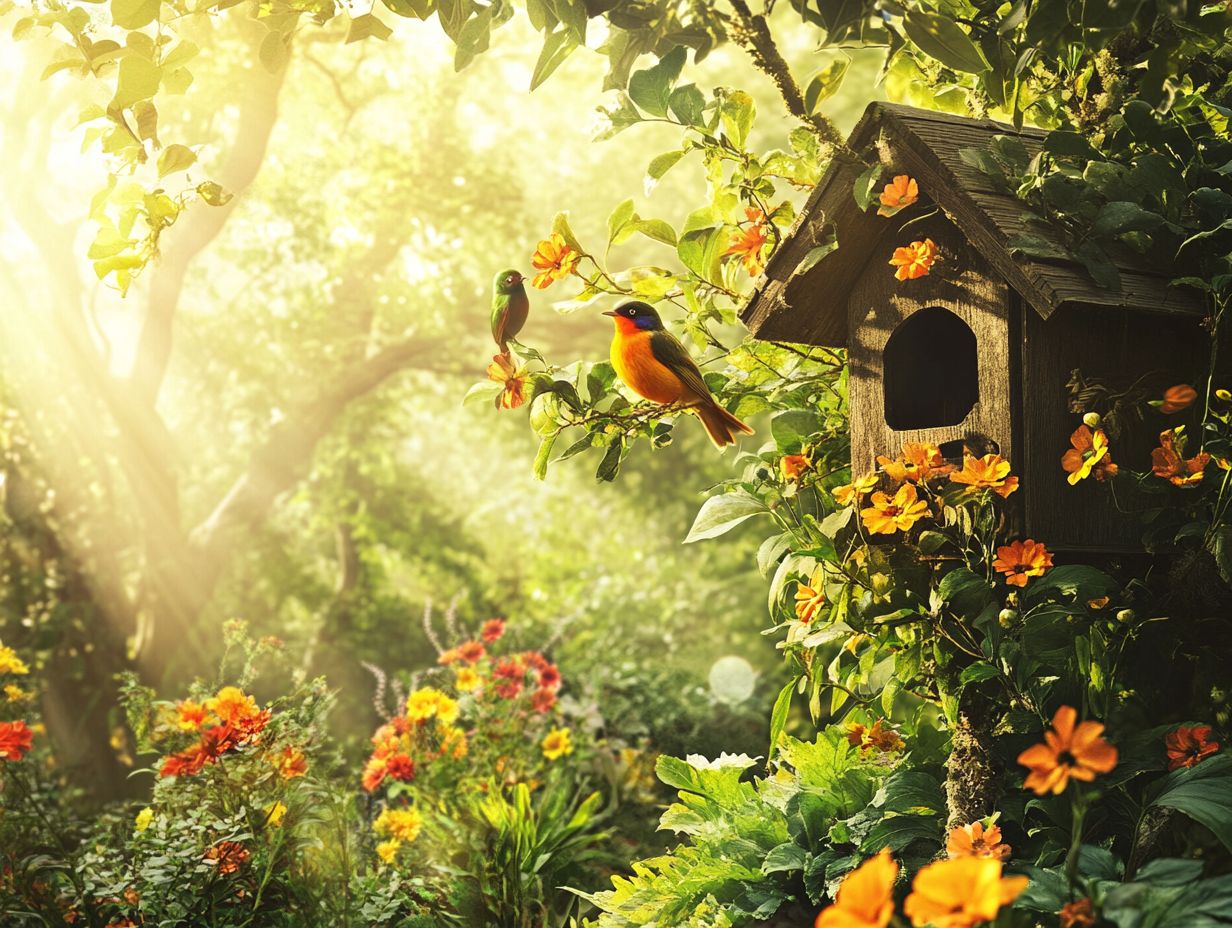
Shelter and nesting areas are crucial for birds, providing essential protection from predators and harsh weather conditions, which directly influence their reproductive success.
A range of shelter types, such as dense trees and shrubs, ensures safety and serves as prime locations for nesting.
For example, the American robin often prefers to build its nests in the sturdy branches of deciduous trees, where it finds the perfect camouflage among the leaves.
In a similar vein, the house finch is known for utilizing the ledges of buildings as its unique nesting sites.
Common Threats to Bird Habitats
Knowing the threats to bird habitats can empower your conservation efforts. These threats include habitat loss, climate change, and predators that disrupt the delicate balance of ecosystems.
Recognizing these challenges gives you the power to take meaningful action in safeguarding avian populations and their environments.
Predators and Environmental Hazards
Predators and environmental hazards present significant risks to bird habitats, jeopardizing their survival by disrupting vital nesting sites and food sources.
Various predators, including domestic cats and invasive species like rats, can devastate bird populations by feasting on eggs and fledglings.
The struggle for survival becomes even more daunting when faced with environmental challenges that upset the delicate balance of ecosystems.
Pollution from urban areas, especially when it seeps into waterways, negatively impacts the food web that birds depend on. Meanwhile, climate change is reshaping weather patterns, compelling birds to migrate earlier or later than usual.
These threats not only jeopardize the physical safety of avian species but also complicate their ability to adapt to swiftly changing environments, further endangering their very existence.
Creating a Safe Habitat for Different Bird Species
Crafting a safe habitat for various bird species requires a deep understanding of their unique needs for food, shelter, and nesting areas. To learn more about this, check out how to create a bird-safe environment.
By employing effective planting strategies and incorporating examples like bird feeders or water sources, you can create an inviting and nurturing space that meets their specific requirements.
Act now to protect birds by creating safe habitats in your area!
Specific Needs and Considerations
Understanding the specific needs of different bird species is essential for crafting habitats that effectively support their nesting and feeding behaviors.
Each species comes with its own set of unique preferences that significantly impact their reproductive success and overall health. For example, cavity-nesting birds like woodpeckers thrive in environments rich with trees that offer suitable hollows, while open-nesters such as robins gravitate toward dense shrubs or grasslands.
Dietary requirements also vary greatly; some birds, like finches, flourish on a diet abundant in seeds and grains. Others, such as sparrows or warblers, rely on insects and small invertebrates for optimal nutrition.
By acknowledging these preferences and requirements, bird enthusiasts and conservationists can craft meticulously tailored environments that foster thriving avian populations and promote environmental enrichment.
How to Maintain a Safe Habitat
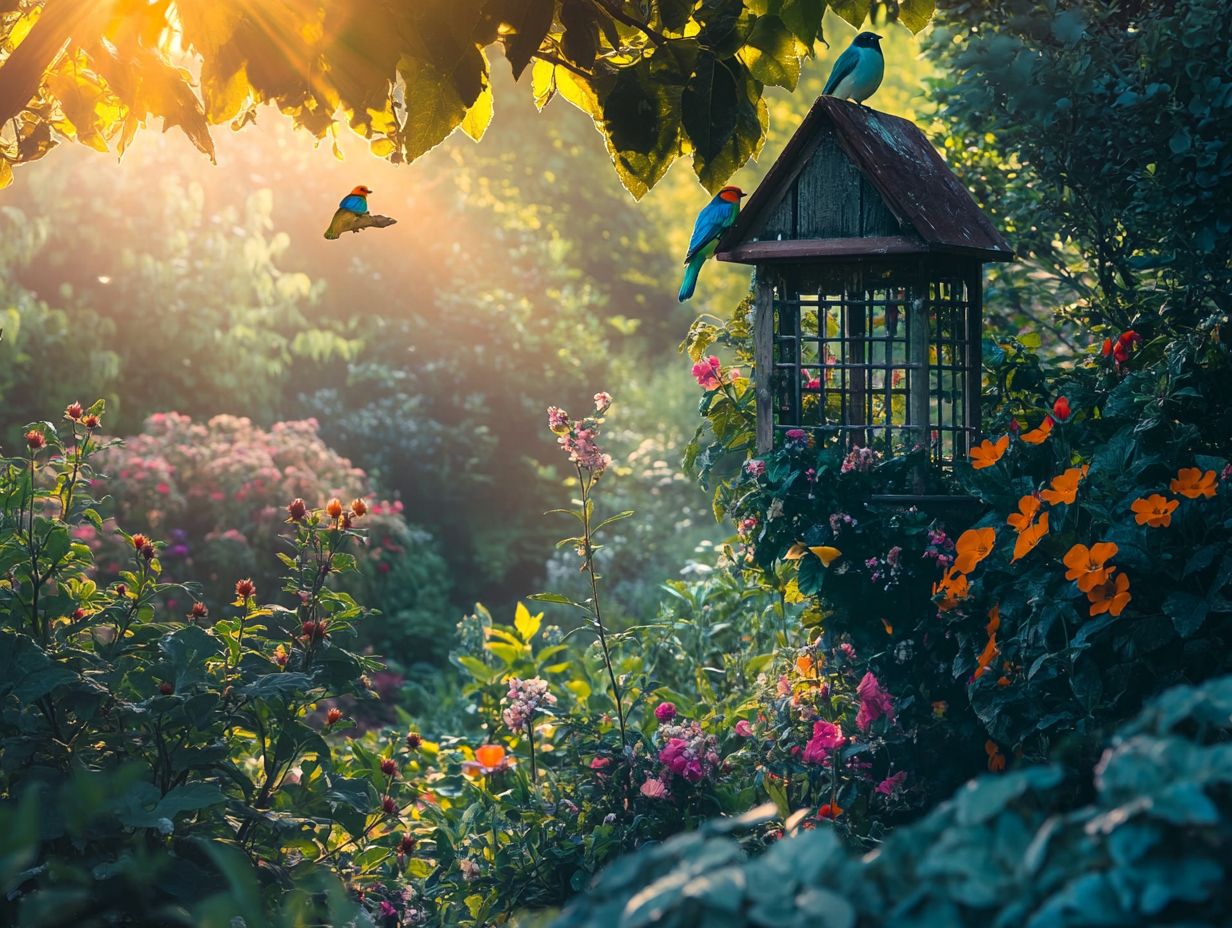
Get excited! Engage in regular upkeep and vigilant monitoring to create a thriving sanctuary for birds. This ensures that critical resources such as food, water, and shelter, including native plants, remain plentiful and well-protected. For more tips on fostering a safe environment, check out this guide on how to create a bird-friendly home for your feathered friends.
Regular Maintenance and Monitoring
Regular maintenance and monitoring of bird habitats are essential practices that help ensure a thriving environment for birds throughout the seasons. Ongoing habitat assessments enable you to understand shifts in environmental changes, allowing for timely adjustments that support the diverse needs of various bird species.
As seasons change, different strategies may be required. For instance, providing additional food sources during migration periods can significantly enhance survival rates.
Implementing regular maintenance routines, such as removing plant species that harm local wildlife and ensuring clean water sources, fosters a healthier ecosystem and supports local bird populations. By incorporating native plants into the landscape, you improve habitat quality and attract beneficial insects.
By embracing these actionable strategies, you can make a significant contribution to the well-being and sustainability of avian populations. Start today your efforts can make a world of difference for our feathered friends and the environment!
Benefits of a Safe Habitat for Birds and Humans
The advantages of a secure habitat reach far beyond just the avian population; they play a crucial role in benefiting entire ecosystems and enhancing human well-being through improved environmental quality.
Safe spaces increase biodiversity and enrich the environment, creating a symbiotic relationship between birds and people in our communities.
Positive Impact on Ecosystem and Well-being
A safe habitat for birds significantly contributes to the overall health of the ecosystem while enhancing your well-being by promoting biodiversity and supporting local wildlife, such as the Great-crested Flycatchers and American Kestrels. To ensure their well-being, it’s important to learn how to create a stress-free environment for birds.
When birds thrive, they play a vital role in pollination, seed dispersal, and pest control key elements for maintaining vibrant landscapes. For example, certain songbird species, including Tree Swallows, help keep insect populations in check, reducing the need for chemical pesticides and nurturing a healthier environment.
Plant nurseries in your area can provide native plants like Blackhaw Viburnum and Purple Coneflower, which further enhance these habitats. The presence of diverse bird populations often indicates good air and water quality, which directly affects your health.
In urban settings, community gardens that attract these feathered friends can beautify the area and promote mental well-being, illustrating how interconnected these ecosystems truly are. By protecting avian habitats, you not only help preserve the intricate web of life but also enhance the quality of life for everyone living nearby.
Frequently Asked Questions
Have more questions? Feel free to reach out and share your thoughts!
What is a safe habitat for bird health?
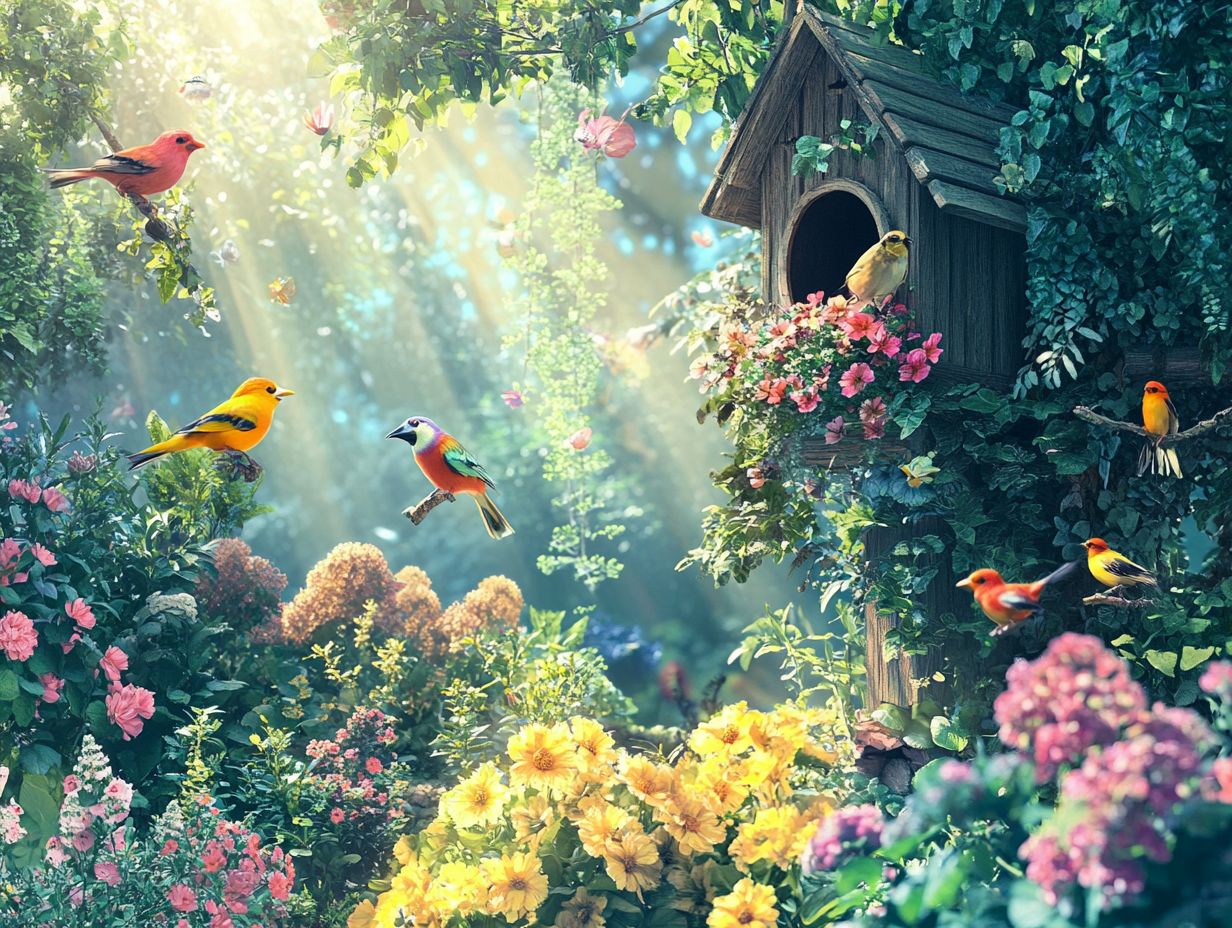
A safe habitat is a vibrant place where birds can thrive and flourish! It includes the essential elements like food, water, shelter, and protection from animals that hunt birds. To learn more about setting up a thriving space, check out this guide on how to create a multi-bird habitat.
Why is it important to create a safe habitat for bird health?
Creating a safe habitat for bird health is crucial. It allows birds to live and reproduce successfully. For more detailed guidance, consider creating a safe outdoor space for your bird, which also helps maintain the balance of the ecosystem by providing a home for various bird species.
How can I attract birds to my yard and create a safe habitat for them?
Act now to create an inviting space for birds that enhances your garden and their well-being! You can plant native plants, provide bird feeders and baths, and avoid using chemicals in your yard.
Leave dead trees and branches for nesting, and provide shelter with birdhouses or shrubs. Include plants such as Wax Myrtle and serviceberry, which attract a variety of bird species.
What are some common threats to bird health in a habitat?
Some common threats to bird health include predators, extreme weather, pollution, lack of food and water, and human interference. Take action now to protect our feathered friends!
It is essential to address these threats to ensure the safety and well-being of birds and enhance biodiversity, which is supported by organizations like the Audubon Society and the National Gardening Association.
How can I prevent predators from harming birds in a safe habitat?
You can prevent predators from harming birds in a safe habitat by using deterrents like netting, fencing, and motion-activated sprinklers. Placing bird feeders and houses away from potential hiding spots can also help keep birds safe.
What should I do if I find an injured or sick bird in my safe habitat?
If you spot an injured or sick bird, don’t worry! Reach out to a local wildlife rehabilitation center for help. You can also report it to the USDA for further guidance.
Handle the bird with care to avoid causing more harm, and provide a safe and undisturbed space for the bird to rest. This is important for its recovery.
